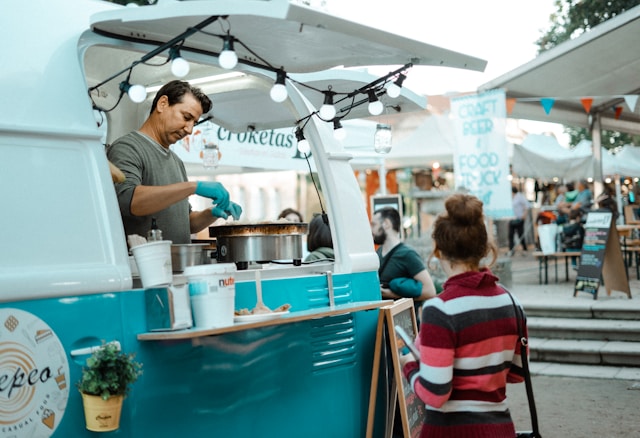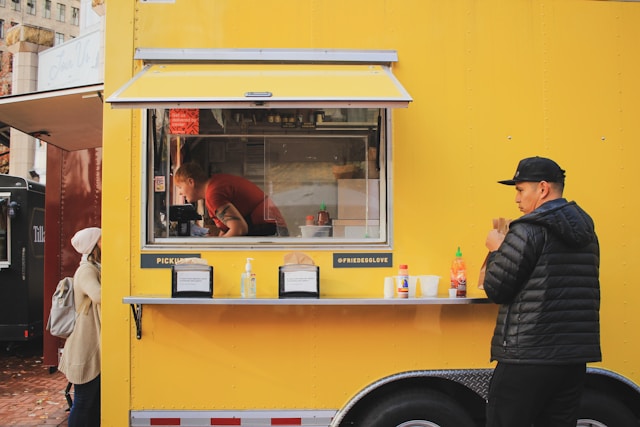Independent food truck owners insurance
Master coverage basics for your mobile food business
Running a food truck comes with unique risks, hot kitchens in tight spaces, limited storage, constant movement, and public exposure. If something goes wrong, the fallout can be expensive. That’s where food truck insurance coverage steps in. This section breaks down the core policies every independent owner should consider and how they affect your bottom line.
Understand the core policies
Most food truck insurance programs start with general liability insurance, which protects against claims related to bodily injury or property damage such as a customer slipping while waiting in line. Without this coverage, a single lawsuit could threaten your entire operation.
Commercial auto insurance is also critical. Your truck is both your workspace and your vehicle, so standard personal auto insurance won’t apply. This policy covers collisions, theft, and damage on the road or at events.
If you’re preparing a food truck insurance application, you’ll likely be offered a business owner’s policy (BOP). It combines general liability with property insurance to cover gear, inventory, and your truck’s interior build-out.
Fill the gaps with optional coverage
Some needs aren’t covered by base policies. Inland marine insurance helps protect mobile equipment like grills and generators when they’re moved off-site. For operations that store or prepare food ahead of time, spoilage coverage can recover costs tied to power loss or equipment failure.
If you handle customer data (like emails for loyalty programs or digital payments), cyber liability may be worth exploring.
Local differences matter
Where you operate affects what coverage is needed and how much it costs. For instance:
- Food truck insurance in California may require higher auto liability limits due to state laws.
- Food truck insurance in Texas might be more affordable but still needs coverage for extreme weather risks.
- In Florida, you might want to add hurricane-related endorsements to your BOP policy.
Searching for food truck insurance near me will help you find local agents familiar with area-specific regulations and seasonal challenges.
Know what to expect on cost
The food truck insurance average cost ranges from $105 to $200 per month depending on your location, services offered, and coverage levels. Your food truck insurance cost per month may be lower if you opt for a bundled plan through a small business insurer or higher if your truck travels to multiple states.
Be ready to fill out a food truck insurance supplemental application if you have unusual exposures, such as participation in high-traffic festivals, use of deep fryers, or alcohol sales.
Estimate insurance costs by policy type
Understanding what you’ll pay for food truck insurance starts with knowing what you’re paying for. Each policy type covers a different risk, and prices vary based on your location, the nature of your operation, and how much protection you choose. This section breaks down typical policy costs and what to expect when preparing a food truck insurance application.
General liability: the foundation of most policies
General liability insurance protects you from third-party claims things like property damage or injuries that happen near your truck. It’s often the first policy new operators buy.
- Food truck insurance cost per month: $25–$70
- Average for annual coverage: around $300–$800
- Included in most food truck insurance programs or BOP bundles
Liability coverage is required by many event organizers and municipalities, especially in states like California, Texas, and Florida. Searching for food truck insurance near me can help identify local minimum limits you’ll need to meet.
Commercial auto: for the truck itself
If you drive your truck (not just park it at events), you’ll need commercial auto insurance. This covers accident damage, theft, vandalism, and some forms of liability while on the road.
- Food truck insurance average cost for commercial auto: $100–$250 per month
- States like Texas and Florida may require higher minimums due to road risk and weather exposure
If you serve in multiple states, make sure your food truck insurance coverage extends across state lines. A provider experienced with mobile businesses can guide you through this.
Workers’ compensation: if you have employees
Most states require workers’ compensation insurance if you have employees. This policy helps cover medical bills and lost wages if someone is injured on the job.
- Typical monthly cost: $60–$130, depending on payroll and job risk
- Required in California even for part-time workers in most cases
You may be asked to submit a food truck insurance supplemental application for this, especially if your business changes in size or staffing.
Business owner’s policy (BOP): bundling liability and property
A BOP combines general liability with property coverage protecting equipment, signage, and supplies. If your truck is customized or you use expensive cooking tools, this is worth adding.
- Monthly estimate: $70–$140
- More cost-effective than buying each policy separately
- Often included in a complete food truck insurance program
When applying, be specific about your kitchen setup, locations served, and average sales volume. This helps insurers quote the right policy and avoid gaps.
The food truck insurance cost you pay will depend heavily on your location, risk exposure, and how many types of protection you need. Operators in California, Texas, and Florida should expect variations in coverage requirements and pricing. Whether you’re comparing quotes or submitting a food truck insurance application, knowing what each policy covers and how much it typically costs will help you stay protected without overspending.

Ways to reduce your insurance premium
Food truck insurance doesn’t have to be expensive especially if you understand how rates are calculated. While your menu, location, and equipment all affect your food truck insurance cost, there are proven ways to keep those numbers manageable. This section offers clear, actionable tips to help you lower your premium without cutting the food truck insurance coverage you need.
Keep a clean safety record
Insurance providers assess risk based on your claims history. If you avoid accidents, injuries, and damage, you’re more likely to get better rates.
- Train staff in safe cooking and service habits
- Maintain fire extinguishers, refrigeration units, and gas lines
- Document safety protocols in your food truck insurance application to support your case
A clean record over time will not only lower your food truck insurance cost per month but can make renewal faster and less complicated.
Consider bundling policies under a BOP
A business owner’s policy (BOP) combines general liability and property insurance. Bundling often reduces your monthly payment compared to buying these policies separately.
- Ask providers if a food truck insurance program includes a bundled BOP
- Make sure all your key exposures such as kitchen gear and signage are listed to avoid gaps
- If you expand operations later, update your policy using a food truck insurance supplemental application
Choose a higher deductible if you can afford it
A higher deductible means you’ll pay more out of pocket if you file a claim, but it lowers your monthly premium. This is a good fit if you have emergency savings or rarely file claims.
- Evaluate deductible tiers carefully when reviewing quotes
- Be realistic about what you could afford in an unexpected repair or lawsuit
Improve truck security and equipment maintenance
Taking steps to reduce the risk of theft or damage can also reduce your food truck insurance average cost.
- Install GPS trackers, alarms, and locking systems
- Park in secure lots overnight
- Keep a maintenance log for fryers, coolers, and propane systems
These measures show underwriters that your operation is well-managed and proactive.
Work with a local agent
If you’re searching for food truck insurance near me, local brokers can often guide you toward discounts specific to your state or city. They may also have better insight into permitting requirements and liability limits in areas like California, Texas, or Florida.
Reducing your food truck insurance cost starts with risk awareness. By operating safely, bundling smartly, and working with agents who know your market, you can stay covered without overpaying. When filling out your next food truck insurance application, use these strategies to highlight your low-risk profile and keep more money in your business each month.
Choose the right insurer for your needs
Not all insurance providers understand the food truck business. Some offer standard small business packages that miss key details. Others specialize in mobile operations and know what you need to stay compliant and protected. This section walks you through how to choose a provider that fits your operation and how it affects your overall food truck insurance cost.
Compare national, regional, and specialty options
Larger insurers often provide wider coverage networks and faster claims processing. Smaller or local providers may offer more hands-on service, especially if you’re operating in one state like California, Texas, or Florida.
- National carriers often list food truck insurance programs online with quote tools
- Local agents can better guide you through permitting, health inspections, and food truck insurance applications
- Specialty insurers may include extras like pop-up event coverage or low-cost inland marine options
Search terms like food truck insurance near me can help identify providers familiar with your city’s vendor rules and event requirements.
Ask the right questions before signing
Before you commit, make sure the provider understands your business model and risk areas.
- Does the policy cover cooking with open flames or deep fryers?
- Are off-site events, catering jobs, or seasonal markets included?
- Can they handle a food truck insurance supplemental application if your business grows or shifts?
If a provider offers pre-built packages, confirm the limits meet your local standards especially if you operate in states with strict minimums like food truck insurance California or Florida.
Review claim support and flexibility
When something goes wrong, you’ll want fast help. Look into the provider’s claims process, response time, and how they handle mobile-based businesses.
- Do they allow photo-based claims submissions?
- Are Certificate of Insurance (COI) requests processed quickly for event entry?
- Can coverage adjust as you move between counties or across state lines?
A good insurer makes it easy to grow your business without constant policy changes or added fees.
Takeaway:
Choosing the right provider affects far more than your food truck insurance cost per month. The right insurer understands your setup, offers the right food truck insurance coverage, and helps you avoid unexpected gaps. Take the time to compare multiple options, especially if your operation spans regions like Texas or Florida, or if you regularly attend events with special requirements. That way, you’ll get a policy that fits and peace of mind that lasts.


